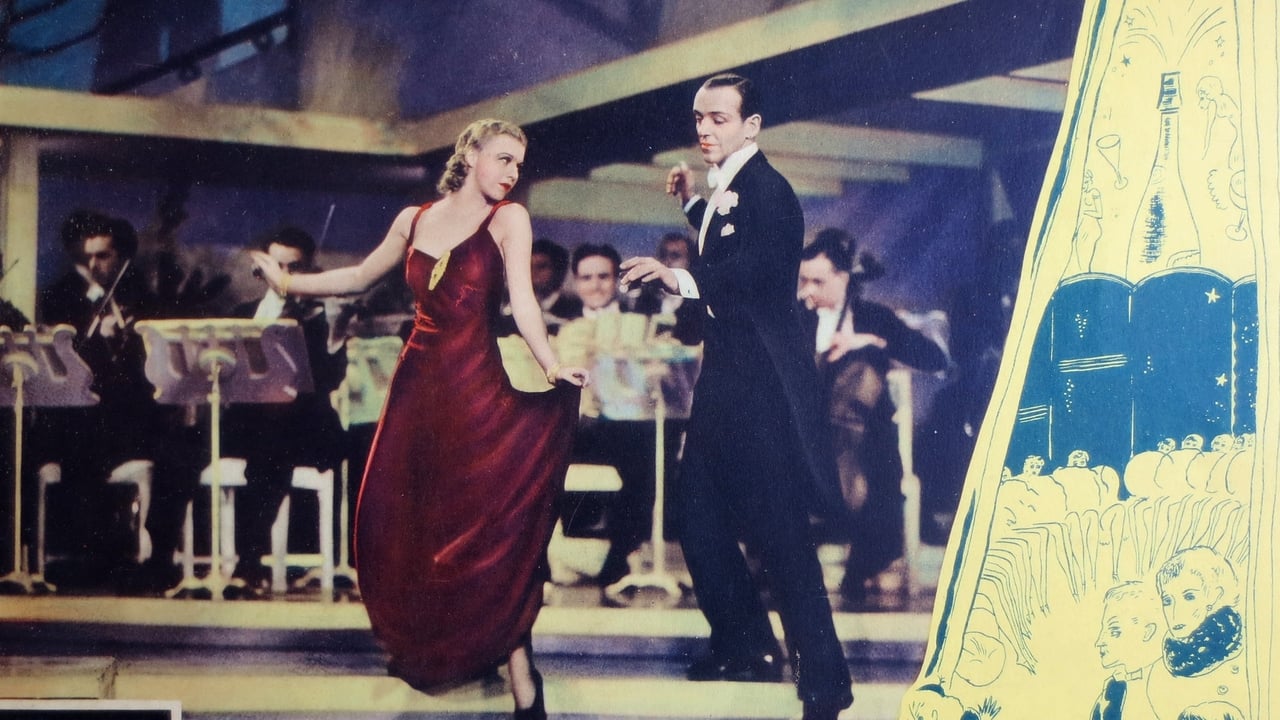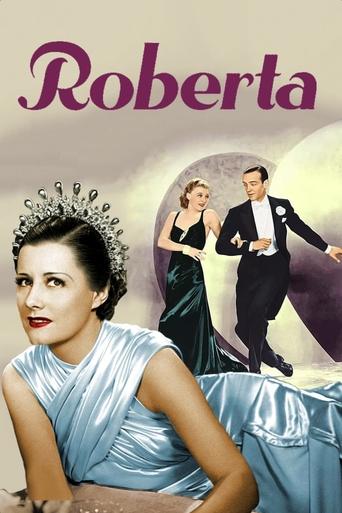

I enjoy the mainline Astaire-Rodgers musicals. They have a certain grace, shine, and wit to them that always makes for an enjoyable hour and a half, usually accompanied by great music.Roberta is somewhat different from the standard formula, though. As with Flying Down to Rio, Astaire and Rodgers aren't the lead couple here. Whereas in FDTR the main couple was not particularly interesting, however, at least for me, here they, or at least the female half of it, Irene Dunne, are outstanding. Her performances of "Yesterdays," "Smoke Gets in Your Eyes," and, to a lesser extent, "You're Lovely to Look At," are beautifully sung - yes, she's not dubbed - and acted, and real highlights of any movie. She was a great actress, and between her and Helen Westley, who does a great job with her small role at the beginning of the picture, the two give the movie a quality serious side that makes Astaire-Rodgers look that much better for the contrast - very much along the lines of the Silver Age Viennese operettas of Lehar and Kalman of which this is something of an echo. Dunne had played the role in the successful touring company of the show before the movie was filmed, so she knew the part and how to play and sing it well, and that benefits the movie.And Randolph Scott is perfectly good in a very two-dimensional role as the mid-Western American who is offended by the sexier aspects of French culture - which, however, is not portrayed as in any sense too outrageous.An exceptionally good 1930s musical. Not all fluff, but the fluff too is excellent.
... View MoreOnce upon a time, audiences went to see musicals like this expecting melodies you could whistle on the way out of the theater, and American composers delivered. It seemed songs you could sing were a dime a dozen back then -- it was called "Tin Pan Alley." But now they are enshrined in "The Great American Songbook," a list of the greatest American songwriters and their works from the 1920s to 1950s, whose posthumous rolls seem to expand every year. "Roberta," a musical largely forgotten today, was the cradle of some of those classics, including "Smoke Gets in Your Eyes," "Lovely to Look At," and "I Won't Dance" (which was wonderfully reinterpreted in "Warm Springs), plus some forgettable but amusing 1930s novelty numbers, such as playing an organ made up of the band members' gloves. Audiences went to Fred Astaire - Ginger Rogers movies to see great dancing to great music. A great plot and great acting would be nice (such as in "Top Hat") but weren't essential. Hollywood kept trying to come up with new vehicles for this duo, with varying success, but always with fine music and dancing. "Roberta"'s plot is about average for the genre, and is worth seeing -- once. If you took the music and dancing out, how many stars would it get?The songs here are not as closely integrated into the plot as they would be in later musicals beginning with Rodgers and Hammerstein, although "Showboat" of 1936 by Kern and Hammerstein was more successful in this regard. But in both "Showboat" and "Roberta" we have musical performers in the plot as an excuse for the music. Irene Dunne's superb singing was one of the surprises of "Roberta." It turns out she was a thoroughly trained singer; she also sings in "Showboat." Sadly, she did not get to use her fine voice more, but she was an older actress by the time of the great musicals of the late 1940s and 1950s. Unlike some musical stars, she was able to easily transition to straight dramatic parts, such as "I Remember Mama."I was also surprised to see some hot piano keyboard action by Fred Astaire. I think one reason audiences adored Astaire is that although he was a multi-talented singer, dancer, actor (and sometimes musician), he made it look so effortless and had an innate modesty.Check out Candy Candido, the band member whose voice keeps changing registers. He was the voice of the angry apple tree in "The Wizard of Oz," and did some voices for Disney. And keep an eye out for an anonymous Lucille Ball, who is one of the fashion models. This is a movie you will probably only want to see once, unless you wait long enough, in which case you probably won't remember any of the plot, anyway.
... View More"Roberta" is one of the best high quality entertainment movies of the first century of film-making. What a delight! It is clean, fun, romantic, clever, colorful and exciting entertainment from start to finish. I agree with the review of trpdean of New York, NY (13 January 2005) – it's captivating! What's not to like?Some critics or reviewers have a penchant for labeling comedy-romance musicals as having "thin" plots. Hmmm! Perhaps they want to be watching a heavy drama or mystery flick instead? Let's face it – entertainment that has half a dozen or more songs, as many dance numbers, some comedic hijinks and romance on the side, doesn't need a heavy, complicated plot. Nor does it have time to develop one. But for the less than two hours that "Roberta" has, its plot is very good and just right for tying together all of these entertainment pieces. I won't give the plot away here, but it does have a different twist. And, it's as believable as any piece of fiction or biography or history one might read. Based on a Broadway Play, this movie delivers laughs, smiles, warmth and a happy feeling throughout. Yes – a guy can even enjoy the one long fashion parade aspect – if for no other reason than to see what the well-to-do fussed over fashion for in the 1930s. Some folks have commented about Fred Astaire and Ginger Rogers having second billing. Irene Dunne was certainly a top star at the same time, and as with any film, someone has to be listed first. Usually, "the" star or headliner of a film has the majority or largest part in the movie or play. But this film had nearly equal time for the three main characters – Irene, Fred and Ginger; and Randolph Scott had a considerable amount of time. This was a very unusual role for Scott – we're used to seeing him in Westerns and as aloof and tough in many films; but here he played a good guy from next door, college athlete, and decent and considerate guy. To his ex-girl friend of course, he was a country bumpkin because he wasn't educated in the ways of the world. But, he played the decent, honest, forthright character perfectly. It all worked for the best, and to me, "Roberta" is a great example of a movie that has several stars of equal or near-equal billing for their great talents. The rest of the main supporting cast added to the enjoyment of this film as well. So, this film has some tremendous music numbers and dance routines, two very nice romances that fit snugly, wonderful humor, a fine display of fashion, and a peek at life lived in the upper crust in 1930s Paris. One last word on the very fine plot ("thin" to some others) -- I didn't suspect the true identity of Dunne's character – it was so well hidden from us until toward the end. But then, I suspected that at the end of the movie she would "spill the beans" about knowing the truth about the countess (Rogers) all along. Of course, that didn't happen, so we were fooled again and left with just a great two hours of top entertainment from two handsful of first class performers. "Roberta" is indeed a gem among classic films of the 20th century.
... View MoreI'm not sure I get the lower-than-usual IMDb voter rating for "Roberta" vs. "Shall We Dance" (1937) and some of the other weaker Astaire & Rogers films. The script and dialog are =far= better than "SWD" and "The Story of Vernon & Irene Castle" (1939) even if the musical numbers are not quite up to say, "A Damsel in Distress" (1937), "Follow the Fleet" (1936), or the remarkable, if somewhat technically inferior, "Flying Down to Rio" (1933).I imagine that R&A fans might have wanted more dancing and less Irene Dunne and Randolph Scott ("Randolph Scott!"), but the lead love story featured two of the =very= hottest stars of the day, much as Gene Raymond and Delores Del Rio (in "FDTR") were in '33. Question: Did Dunne insist on singing in the old "bel canto" style to try to keep up with Rogers? She shouldn't have. Ginger's waaaaay out front here, and no one's going to catch her. In fact, this =is= the best of Rogers's acting performances in the entire series. Dancer, glib wisecracker, foreign accents and comedic timing galore. That, and boy, did Bernie Newman put her in some utterly =breathtaking= art deco outfits.Speaking of fashions, if you're into =that=, Roberta's a film about a fashion designer, and the fashion show scenes are black & white mind blowers.Musically, the memorable tunes include "Lovely to Look At," "I'll be Hard to Handle" and "Smoke Gets in Your Eyes," respectively by Eddie Duchin, Gerry Kern and Gerry Kern; not exactly a couple of lightweights... and Al Newman handles them superbly.The digitally restored print they've been showing on TCM is terrific, btw.
... View More